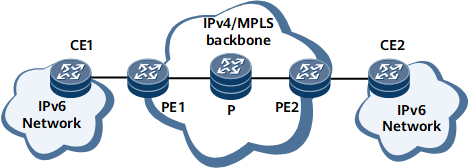Enabling the Device to Recurse BGP IPv6 Unicast Routes to Tunnels
By default, BGP IPv6 unicast routes can recurse to outbound interfaces and next hops, but not to tunnels. A device can be enabled to recurse BGP IPv6 unicast routes to tunnels.
Usage Scenario
On the IPv4/MPLS backbone network shown in Figure 1, PE1, P and PE2 run an IGP for interworking, an LDP LSP or MPLS TE tunnel is established between PE1 and PE2, and an IPv6 EBGP peer relationship is established between CE1 and PE1 and between CE2 and PE2. In addition, an IBGP peer relationship is established between PE1 and PE2 using their loopback interface IP addresses, and PE1 and PE2 are enabled to exchange BGP IPv6 unicast routes in the BGP-IPv4 unicast address family view. CE1 sends an IPv6 route to PE1 through the EBGP peer connection. Upon receipt of the route, PE1 changes the next-hop IP address of the route to a local IP address and sends the route to PE2 through the IBGP peer connection. After PE2 learns the IPv6 route, it can recurse the route only to an outbound interface and next hop by default. However, PE2 can be enabled to recurse BGP IPv6 unicast routes to tunnels.
Pre-configuration Tasks
Before enabling the device to recurse BGP IPv6 unicast routes to tunnels, complete the following tasks:
Configure an IGP.
Establish an LDP LSP or MPLS TE tunnel between PE1 and PE2.
Establish an IBGP peer relationship between PE1 and PE2 using their loopback interface IP addresses, and enable PE1 and PE2 to exchange BGP IPv4 unicast routes in the BGP-IPv6 unicast address family view.
Procedure
- Run system-view
The system view is displayed.
- Run bgp { as-number-plain | as-number-dot }
The BGP view is displayed.
- Run ipv6-family unicast
The BGP-IPv6 unicast address family view is displayed.
- Run unicast-route recursive-lookup tunnel-v4 [ tunnel-selector tunnel-selector-name ]
The device is enabled to recurse BGP IPv6 unicast routes to tunnels.
To enable the device to recurse BGP IPv6 unicast routes to MPLS TE tunnels, specify tunnel-selector tunnel-selector-name in the command.
- Run commit
The configuration is committed.
Checking the Configurations
After the device is enabled to recurse BGP IPv6 unicast routes to tunnels, you can run the display bgp ipv6 routing-table ipv6-address command to view route recursion information.
